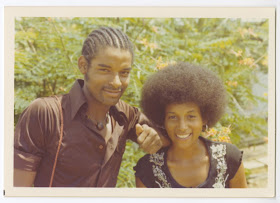There is a church a block away from where I live. I go there to visit a tree. One of its branches has descended upon the earth, bending heavily from its weight; a forked stick helps support it and hold it up. I also go there to see a spirit mural. It is a beautiful mosaic of a white-tailed dove crowned with what I imagine is intended as a symbol of the holy spirit. Some may interpret it a phoenix rising. Its tail spreads across four columns of the church, spawning various symbols—hearts, shells, angels, and my favorite, a couple - the silhouette of a man and a woman. My idealist self places her fingers on the shadowy figures and yearns, wishing for these symbols to materialize into existence. This idealist yearning, this ideal is something like the glimpses of paradise that I see in the eyes of the believers in Peoples Temple, particularly in the photographs of the children, the dancers, and the older women who believe in the possibility of healing, of all races coming together as a unit under the banner of love.
 |
| Child with baby sloth, circa 1974-1978; Peoples Temple Publications Department Records, MS 3791; Box 30, folder 6; California Historical Society. |
Working on the Peoples Temple photographs and some of the textual material gives one a glimpse into the ideal that was sought from its conception. Perhaps you come upon a beautiful child taking a stroll in the jungle at Jonestown, discovering a flower and pausing for a moment to consider it and hold it with care.
 |
| Child with flower, circa 1974-1978; Peoples Temple Publications Department Records, MS 3791; Box 30, folder 6; California Historical Society. |
 |
| African dancers, circa 1975-1976; Peoples Temple Publications Department Records, MS 3791; Box 30, folder 2; California Historical Society. |
 |
| Woman at church service with Jim Jones, circa 1974-1978; Peoples Temple Publications Department Records, MS 3791; Box 31, folder 2; California Historical Society. |
 |
| Two youth in Jonestown, circa 1974-1978; Peoples Temple Publications Department Records, MS 3791; Box 30, folder 4; California Historical Society. |
“Each of us in his destined hour, in hope or extremity, mounts the steps of idealism. In all times and places, fervid youths have climbed in search of idealism, driven upward by sight of the seething plain of life across which the light of brotherhood appears at times to burn fitfully. Too many of them have climbed in vain.”
Sometimes the young of spirit desire to undo the imperfect system that keeps the light of brotherhood from burning with a peaceful flame. We dare give birth to hope and begin to climb the mountain of idealism, leaving the plain of life behind; almost obliterating it and starting anew with our own thoughts, on our own terms, seeking like-minded people. We want paradise on earth, now. We tire of waiting for elusive promises. This, however, can be a dangerous proposition. Humans are imperfect beings embedded with foibles and faults, often drawn to extremes. Often reacting to others’ extremes—from greed to idealism. The lessons imparted to us in the narratives of the Peoples Temple and those who seek to explain the church are often extreme, understandably mirroring such narratives. But what about the lessons imparted in the brief glimpses of the promise of paradise the eye may draw from some of the photographs? Can anything be extracted from these? Even if there’s a strong possibility that some of it was curated to fit the purpose of publication?
I think there is something important to be extracted from these brief glimpses. I think part of the lesson lies in contemplating the extremes, sure, but also, considering the journey in between, the fissures where love was let in. This is a quiet journey that involves reflection, pause, and silence.
 |
| Church members praying during service, circa 1965-1978; Peoples Temple Publications Department Records, MS 3791; Box 30, folder 9; California Historical Society. |
The Peoples Temple photographs give us glimpses of a paradise the youth in us has yearned to see. But did many of them climb in vain? I like to think that the climb was not in vain. I like to do a challenging thing—to turn from the sensationalized end and pause a bit to study the faces of the people whose life held meaning and the potential for a longer, better life. The idealist in me keeps searching for these glimpses, hoping they bloom and multiply and one day materialize like during my yearning by the spirit mural. The realist in me, however, reminds herself to also temper such yearning given the nature of man and its excesses. It’s a challenging task—to both acknowledge the end, to grasp the fitful yearning of utopia so as to temper it and prevent it from happening again, but also to not forget the fissures and glimpses of paradise where life and love seeped through.
 |
| Woman with baby girl, circa 1974-1978; Peoples Temple Publications Department Records, MS 3791; Box 30, folder 4; California Historical Society. |
Written by Lynda Letona, Assistant Archivist & Reference Librarian at California Historical Society (CHS).
Photos digitized by Marissa Friedman, Imaging Technician and Cataloger at CHS.
A finding aid for the People Temple collection can be found here.
References:
Brown, Hugh. 1950. Foreword to Tetecan: An Aztec tragedy. San Francisco: Bohemian Club.
Photographic Prints, circa 1965-1978; Peoples Temple Publications Department Records, MS 3791; California Historical Society.
Photos digitized by Marissa Friedman, Imaging Technician and Cataloger at CHS.
A finding aid for the People Temple collection can be found here.
References:
Brown, Hugh. 1950. Foreword to Tetecan: An Aztec tragedy. San Francisco: Bohemian Club.
Photographic Prints, circa 1965-1978; Peoples Temple Publications Department Records, MS 3791; California Historical Society.
The processing of this collection was made possible by
funding from the National Historical
Publications and Records Commission (NHPRC).

No comments:
Post a Comment